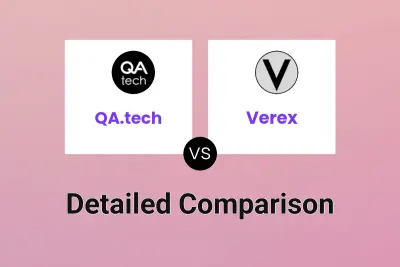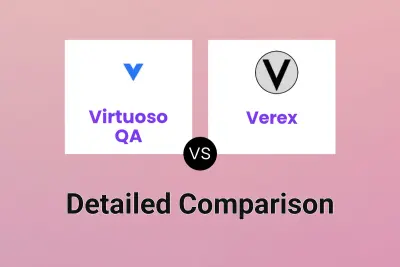 Virtuoso QA
VS
Virtuoso QA
VS
 Verex
Verex
Virtuoso QA
Virtuoso QA is a comprehensive, AI-driven test automation platform designed to streamline and enhance the software testing process. It utilizes Natural Language Programming (NLP) and Robotic Process Automation (RPA), creating a powerful and scalable solution for testing web applications.
With Virtuoso, teams can author tests in plain English, accelerating test creation and making it accessible to non-technical users. Its self-healing capabilities, powered by AI and Machine Learning (ML), significantly reduce test maintenance costs and improve test reliability. The platform offers comprehensive test coverage, supports continuous testing within CI/CD pipelines, and provides detailed reporting with AI-generated insights for failed tests.
Verex
Verex offers an AI-driven solution designed to automate Quality Assurance (QA) processes for web applications. It enables users to define test suites by describing test requirements in natural language, removing the necessity for traditional coding or scripting. This approach aims to significantly reduce the time spent on manual testing, script creation, maintenance, bug logging, and test data management, potentially saving numerous engineering hours each month.
The platform integrates with existing development workflows, allowing tests to be triggered through CI/CD pipelines, tools like Slack or Teams, or manually via its user interface. Upon execution, Verex provides detailed test reports featuring screenshots and insights. It also automates bug tracking by creating tickets directly in platforms such as Jira and Trello, facilitating faster debugging and issue resolution. Verex adapts dynamically to UI changes, reducing the maintenance overhead associated with fragile test selectors.
Pricing
Virtuoso QA Pricing
Virtuoso QA offers Paid pricing with plans starting from $620 per month .
Verex Pricing
Verex offers Freemium pricing with plans starting from $29 per month .
Features
Virtuoso QA
- Natural Language Programming: Write tests in plain English, similar to manual test cases.
- Self-Healing Tests: AI and ML-powered capabilities automatically adapt tests to UI changes.
- Robotic Process Automation (RPA): Combines NLP and RPA for comprehensive test automation.
- Root Cause Analysis: AI-generated insights help identify the reasons for test failures.
- Combined UI and API Testing: Integrate functional UI testing with API calls.
- Reports and Analytics: Provides detailed testing analytics that show test results.
Verex
- Natural Language Test Creation: Define test suites using simple descriptions instead of code.
- AI-Driven Automation: Execute tests automatically without manual scripting or setup.
- Flexible Test Triggers: Initiate tests via UI, chatbot, Slack/Teams, or CI/CD pipelines.
- Visual Debugging: Receive detailed reports with screenshots and actionable insights.
- Automated Bug Tracking: Automatically create and manage bug tickets in Jira/Trello.
- Seamless Integrations: Connect with GitHub, GitLab, Bitbucket, Jenkins, Slack, Teams, Jira, and Trello.
- Dynamic Adaptation: AI understands tests in natural language and adapts to minor UI changes, reducing maintenance.
- Actionable Insights: Get AI-generated suggestions for continuous testing process optimization.
Use Cases
Virtuoso QA Use Cases
- Functional UI Testing
- End-to-End Testing
- Continuous Testing and CI/CD
- Regression Testing
- Cross-Browser Test Automation
Verex Use Cases
- Automating end-to-end web application testing for Enterprise DevOps teams.
- Accelerating product launches for Tech Startups and SaaS companies by reducing QA bottlenecks.
- Reducing repetitive manual testing tasks for QA Engineers and Testers.
- Achieving faster release cycles and enhanced software stability for Product Managers and CTOs.
- Delivering high-quality software more efficiently for Agencies and Development Firms.
- Providing robust testing capabilities for Freelance Developers and Consultants without overhead.
FAQs
Virtuoso QA FAQs
-
Is there any Virtuoso QA-specific terminology?
Yes, we have a handful of phrases to describe the different segments of tests.Project - The highest level of organization in Virtuoso QA, your project should have a large overarching theme, like a whole domain or applicationGoal - Goals fit inside your projects, and each goal has its own set of data. They should be smaller chunks of tests like testing a subdomain or a specific functionality of your app.Journey - Ideally, journeys represent an end-to-end journey that a user would take through your appCheckpoint - Checkpoints are within your journeys and might be separated based on moving from one page of an app to anotherLibrary Checkpoints - Checkpoints that are added to a library so they can be reused in other journeys or goals within the projectStep - Test steps are the smallest slice of the test authoring process. A step is a single action a user can take, like clicking a button, writing in a text field, or navigating to new pages.Environment - Environments are contained at the project level, and each one has its own data, files, and bridge -
Can Virtuoso QA test behind our firewall?
Yes! We have a bridge client to run on your network to create a secure TLS-encrypted tunnel to pass the traffic to Virtuoso QA. -
What types of testing can Virtuoso QA run?
We can run functional, end-to-end, UI, and integration testing. You can also make API calls within your functional tests. -
What kinds of applications does Virtuoso QA test?
We test any browser-based application, and our cross-browser capabilities allow for testing on any browser on any device. -
Can Virtuoso QA integrate with external tools for ticketing or issue tracking?
Yes! We have a fairly long list of integrations, including Slack, GitHub, MS Azure DevOps, Jenkins, XRay, TestRail, and Jira. However, if you don’t find your preferred app on our list, we have an open API so you can configure custom integrations.
Verex FAQs
-
Do I need to write any code or scripts to use Verex?
No, Verex's AI agents interpret natural language commands, eliminating the need for manual coding or test scripting. -
What types of tests can I perform with Verex?
Verex supports a wide range of tests for web apps accessible via a browser, including login flows, security checks, UI consistency, and custom ad-hoc scenarios. It is not suitable for internal web apps unless exposed to the public internet. -
Which integrations does Verex support?
Verex seamlessly integrates with Slack, Teams, Jira, Trello, GitHub, GitLab, Bitbucket, and Jenkins. -
How does Verex improve testing efficiency compared to traditional methods?
Verex automates repetitive tasks and uses natural language understanding to adapt to UI changes, reducing test maintenance overhead associated with fragile selectors used in traditional automation. -
Is my data secure with Verex?
Yes, Verex employs industry-standard security measures to manage test credentials and sensitive data securely.
Uptime Monitor
Uptime Monitor
Average Uptime
99.7%
Average Response Time
208.87 ms
Last 30 Days
Uptime Monitor
Average Uptime
100%
Average Response Time
227.9 ms
Last 30 Days
Virtuoso QA
Verex
More Comparisons:
Didn't find tool you were looking for?

